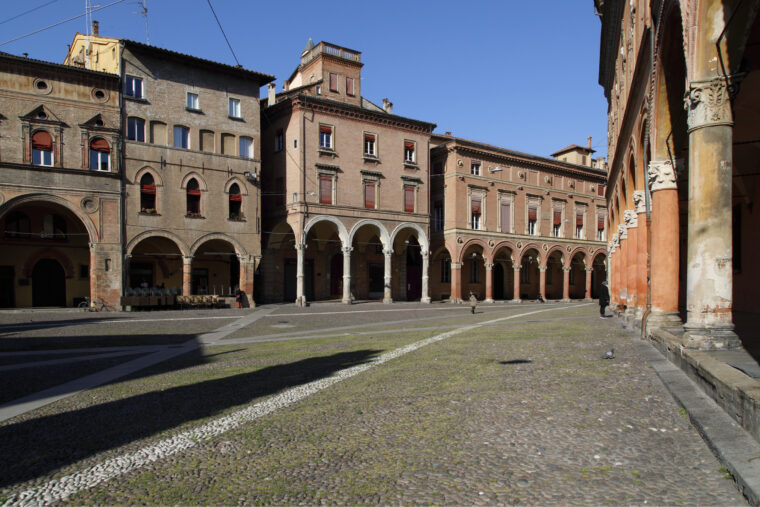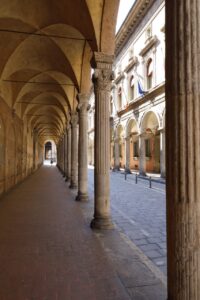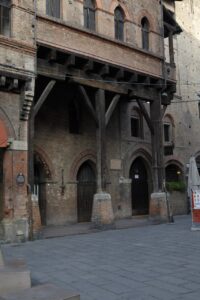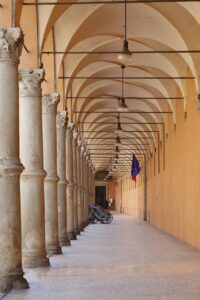Aksamija Helps Porticos of Bologna be Named a UNESCO World Heritage Site


Associate Professor of Art History Nadja Aksamija got her first glimpse of Bologna, Italy back in 2004 as she walked from the train station towards the historic city center. It was a hot day and she dragged her suitcase down the sidewalk.
Crossing Piazza Maggiore, Aksamija stepped into the shade of Palazzo dei Banchi, experiencing for the first time the city’s breathtaking porticos – extensions from the upper levels of structures that create about 37 miles of covered walkways alongside city streets.
“I remember thinking that this was incredible,” Aksamija said. “It felt like a changing landscape.”
While the porticos create surface uniformity to the streetscape, closer examination reveals a constantly shifting environment. The gorgeous columns vary as you walk underneath. The light changes. The floor heights shift. Life teems underneath the porticos, with shops, cafes and bars, and live music giving the space character and dimension. Aksamija thought it was a fascinating hybrid between a city square and someone’s living room.

Recently, Aksamija played an important role in ensuring that this charmed space would remain a protected part of Bologna’s cultural heritage. A series of the 12 most representative sections of portico were recently added to the United Nations Educational, Scientific and Cultural Organization’s (UNESCO) World Heritage List in recognition of their “Outstanding Universal Value.”
“Defined as private property for public use, the porticos have become an expression and element of Bologna’s urban identity,” according to the UNESCO website.
Aksamija prepared and presented materials in English necessary for the recommendation by the International Council on Monuments and Sites (ICOMOS) to place Bologna’s porticos on the UNESCO World Heritage List. She joined the 15-year-old project in 2020 at the invitation of Bologna’s city government and Francesco Ceccarelli, a professor of architectural history at the University of Bologna.

Aksamija fielded inquiries from ICOMOS about their research, the history of the architectural features, and how the nominating team determined which porticos were recommended for the important designation. “A lot depended on this going well,” she said of the January 2021 meeting.
UNESCO’s World Heritage Committee voted in favor of the designation in July. “By submitting a nomination, a country pledges to take good care of the site in terms of conservation and restoration. It basically promises to respect its protected status,” Aksamija said. “You are saying that this has great importance for humanity. It’s world heritage, not just Italian heritage.”

A common architectural feature in the medieval era, porticos are all but extinct everywhere but Bologna. In places like Rome and Florence, for example, most porticos were demolished in later centuries to give greater primacy to individual palace facades. “In other Renaissance cities, powerful families really wanted to show off their individual palaces rather than have them blend with the rest of the urban landscape,” Aksamija said.
The Bolognese took what was once illegal and recast it in a more utilitarian light. Students at the University of Bologna – the oldest university in the Western world, founded in 1088 – needed places to live and the increased space of the porticos may have allowed residents to earn rental income. Municipal statutes made the portico mandatory for all new construction starting in 1288, a law that has never been abolished. It is the rare instance of private property being specifically designated for public good, she explained.
“In Bologna, everything is built into this continuum. Nobody sticks out. Once a medieval commune, Bologna was always a city more focused on the communal good than on the individual celebration of a single ruler,” Aksamija said.

The porticos don’t only represent a unique architectural type—the communal nature of the porticos embody the spirit of a lively community, one that Wesleyan students get to experience through the university’s study abroad program in Bologna.
“Our students love Bologna—its intellectual vibrancy, incredible food (tortellini!), and beautiful portici, among many other things,” Aksamija said. “I am hopeful that the fact that Bologna is now a UNESCO World Heritage site will inspire even more of our students to study there in the future.”
Currently, Aksamija is on sabbatical completing a book about 16th-century architecture in Bologna.

